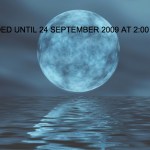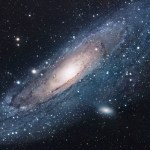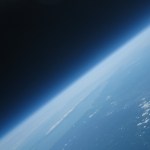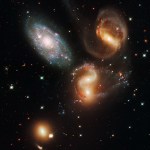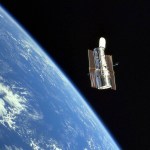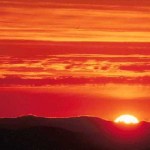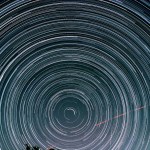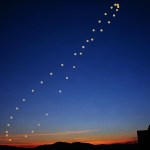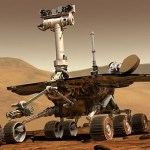Astronomy
Many of you saw the pictures I posted Monday of colliding galaxy clusters. These pictures were spectacular, because they not only show galaxy clusters less than 200 million years after a collision (which is short, cosmically), they also show where the mass lies (traced in blue) and where the X-ray emitting areas are (pink). You get pictures like this one from the Bullet Cluster:
This one from MACS J0025:
And this one from Abell 520:
This is what happens when clusters collide, the normal matter gets separated from the dark matter! Let's tell you how.
Some normal matter is packed together in…
As many of you know, light pollution at night has become a big problem. It's a problem for flora and fauna, which rely on the "day/night" cycle that they've adapted to over billions of years, and it's a problem for astronomers, as the light pollution disrupts observations of the night sky. All over the world, light pollution is visible to anyone looking at the Earth, even from space.
But I've been watching a little bit of Isabella Rossellini's Green Porno, which is a series of entertaining, educational shorts about threatened species and the environmental consequences of eating them.
But…
Last June, scientists were thrilled to find evidence of ice on Mars. Now, the galaxy is again proving to be more abundant in water than believed. Data from the Moon Mineralogy Mapper instrument aboard the Indian satellite Chandrayaan-1 has revealed that the surface of the Moon may be covered in either water or closely related hydroxyl ions (OH-). As much as one quart of water or hydroxyl might be contained in a cubic yard of Moon soil, according to the best estimates from the data. "This could be a huge boon to establishing a Moon base," said Ethan Siegel of Starts With a Bang, "as with water…
The Milky Way is a mysterious swath of darkness and light through the night sky. In places where light pollution is low enough to see it, its beauty is unmistakable.
Well, the above image is what you might see with your naked eye. But even a small telescope can get you so much more. The darkest skies, with your naked eye, can provide you with the opportunity to see a few thousand stars.
But get yourself a small telescope? You're talking about tens of millions of stars, almost instantly. A small telescope, taking a large number of pictures and stitching them together, produced this image of a…
When I was first learning about the science of the Moon, there were a few basic facts that everyone got right. The Moon has practically no atmosphere, as when sunlight hits the Moon, it very quickly can give individual molecules and atoms enough energy to achieve escape velocity. We thought the same thing was true for any water on the Moon; sunlight would kick the water molecules so hard and so often that the molecules wouldn't remain on the Moon for very long, and therefore it would be completely dry.
A watery Moon? Possible at all? Well, there was one hope. You see, the Earth rotates on an…
Andromeda, also known as M31, is the nearest large galaxy to us. At "only" 2 million light-years away, it gives us the best chance to study another spiral galaxy besides our own. I get particularly impressed by the high resolution images we can get, since it's so close to us. Andromeda looks like this in visible light:
And it looks like this in the ultra-violet:
But recently, a few very, very high-resolution pictures were taken, woven together to create a mosaic, and released to the public. The Ultraviolet light one -- made by the Swift satellite -- just came out today, but I thought I'd…
No, not you personally. But if you've ever thought about sending anything up into space, you may want to listen to this story about a couple of MIT students. For less than $150 in parts, with an amazing ease of assembly, they managed to send a device up to the brink of space, take some pictures, and recover the wreckage. At its apex, their entire apparatus reached an altitude of 93,000 feet (more than 28 km), sending it high into the stratosphere, high enough to take this picture:
Well, it isn't technically "space", but it is above more than 90% of the atmosphere and is certainly very, very…
Perhaps my favorite of the new Hubble pictures is this one of Stephan's Quintet (and click here for the 1000 pixel wide version):
It's so stunning that it was chosen as today's Astronomy Picture of the Day. But yesterday, I got a very interesting question to go along with it:
These galaxies are far away, and so we're looking at them in the past. What do they look like today, and are there still five of them?
This is a great question. First off, looking at the image, some of you will count only four galaxies. That's because there are two galaxies that are in the process of merging. You can…
Yesterday, I linked to the Hubble Site, where they've got a collection of stunning new images taken using Hubble's new camera, the Wide-Field Camera 3:
But why would you bother to go there? After all, you know that I'll just show you all the gorgeousness here! Hubble is an astounding telescope, because it's so good for viewing things that are both incredibly close and incredibly far. So here are the highlights!
First off, Hubble can take incredible pictures of our Solar System. Remember that Jupiter recently got hit by an asteroid? Take a look at the big black debris spot by the South Pole,…
I love this question:
Why is it warmer in the summer than in the winter (for the Northern hemisphere)?
Go ahead and ask your friends. I suppose they will give one of the following likely answers:
The tilt of the Earth
The tilt of the Earth makes us closer to the Sun
We are closer to the Sun
Really, that should be at least 85% of the answers. To really answer the question, think of the following key points:
When it is warm in the Northern Hemisphere, it is cold in the Southern Hemisphere
The Earth's orbit around the Sun is very close to being circular
The seasons depend on the time of…
Remember saying goodbye to Hubble's old camera, WFPC2? This servicing mission was months ago, now, so perhaps you've forgotten about this 19 year old telescope.
Well, the new camera, WFC3, is finally ready to make its debut. Plans include surveying the Kuiper Belt, looking at newly forming planets, better measuring dark energy, and a new, improved Ultra Deep Field of the distant Universe.
But, as always, the images are what do it for me. Take Stephan's Quintet, a group of five galaxies close together. Regular telescope? Go, and click to enlarge:
Not bad. But one of the first pictures that…
Sure, we're all familiar with sunsets, and how they appear to turn the entire sky close to the horizon red at night.
But it turns out it isn't just the Sun, and it isn't just the sky. If you look at the Moon at either Moonrise or Moonset, guess what color it appears to be? (Even in urban settings!)
Too difficult to tell? Let's find you a better picture done with time-lapse photography.
What's going on to cause this? Why do things which aren't normally red appear red when you look at them on the horizon, from the Sun to the Moon to the sky itself?
This is all the atmosphere's fault. After…
I love this story. It is a story of how ideas changed about the nature of the atom. These are the notes (and diagrams) I use when I teach the atomic nature of matter to non-science majors. The best thing about this story is that it is a great example of science. Science (or scientists) build a model. If new evidence comes along, the model gets changed. There are several other websites that describe all of this stuff, I will list a couple at the end of this post.
Typical textbook model of an atom
Look in an intro, non-science majors textbook and you will probably see a picture like this…
I'm a pretty optimistic guy. Okay, I'm a really optimistic guy. But even my optimism has its limits when bashing up against the cold hard reality of what experiments plus our understanding of the laws of physics tells us about the universe. Here are my top three most depressing facts about the universe coming from the field of physics and astronomy.
The speed of light. The speed of light is a real bummer, dude. I mean sure, 299792458 meters per second may sound fast, but in comparison to the nearly 40 trillion kilometers to the nearest star, it's not very fast. And considering the…
One of the things I always wondered was why Galileo's Eppur si muove! (And yet, it moves!) was such a big deal. Yes, he was talking about heliocentricity, and the Earth moving around the Sun instead of the other way around.
But I was a little bit puzzled. Why, after all, would the Earth moving be such a revolutionary idea? Every night, if you look up and watch the skies over time, you'll see something like this:
The sky rotates! Not only do the stars in the night sky rotate, but the Sun's path through the sky also goes along one of the same paths that the stars do, as does the Moon. (For a…
Okay, as many of you had heard, I've got a new job as a full-time Professor. And not only am I pretty excited about it, I thought I'd share with you one of the more interesting things I taught on the first day.
I got this idea from talking to Michael, the chair of the department (and this is not the first time he's taught me something neat). Chances are, if you're in a classroom, that one thing everyone has is a piece of paper.
If you folded this piece of paper in half, it would now be twice as thick as it was before:
So my question is this: how many times would you have…
On Monday, I posed a question to you as to why, when you photograph the Sun at the same exact time every day for a year, you get something that's shaped like a figure 8, like so:
Image credit: Tunc and Cenk Tezel.
We got a good number of thoughtful comments, many of which are on the right track, and many of which have some misconceptions. Let's clear them up, and then let's give you the explanation of what gives us our figure 8, and why other planets make other shapes.
What does the analemma look like at other places on Earth? You can see, above, that (from the ruins) the above analemma is…
I'm trying something new here: I'm going to give you a little bit of information and a teaser, and we'll see -- in the comments section -- whether any of you can figure it out.
Imagine that you went outside, each and every day at the same time, and mapped the position of the Sun. What would you see?
Image credit: Astrosurf.
Doing this -- taking a snapshot of the Sun at the same exact time from the same exact place on different days -- gives you what's called an analemma. Now, on Earth, the top of the analemma happens during the Summer Solstice, the lowest point of the analemma happens…
Once a week, all the top astronomy/space writers from around the net get together -- thanks to Fraser Cain at Universe Today -- and contribute their top stories to the Carnival of Space. This week, Mike Simonsen of Simostronomy hosts, and brings together some great stories in this week's Carnival of Space. Go and check it out; here are my top three picks:
1. Robots galore! Ever wonder what your favorite missions to other planets are up to? From as close to the Moon to the outer edge of the Solar System, the Planetary Society has mission updates from Mercury to Saturn to Pluto.
2. An eclipse…
Recently, a discussion started in one of my comment threads about whether the Big Bang was necessarily valid or not, and whether there were any reasonable alternatives. The answer is that not only is the Big Bang the best theory to explain the start and evolution of the Universe, it's the only one that doesn't make incorrect predictions. Let's see this in action.
This all started in the late 1920s, when we realized that spiral nebulae were not just galaxies, but that these other galaxies were nearly all moving away from us. Moreover, the ones that were farther away from us were moving away…



